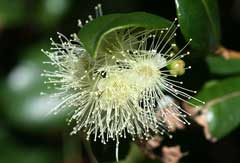 |
|
|
 |
| http://www.flickr.com/people/32005048@N06 |
Translate this page:
Summary
Physical Characteristics

 Syzygium australe is an evergreen Shrub growing to 3 m (9ft 10in).
Syzygium australe is an evergreen Shrub growing to 3 m (9ft 10in).
See above for USDA hardiness. It is hardy to UK zone 7. The species is hermaphrodite (has both male and female organs).
Suitable for: light (sandy), medium (loamy) and heavy (clay) soils. Suitable pH: mildly acid, neutral and basic (mildly alkaline) soils. It can grow in semi-shade (light woodland) or no shade. It prefers moist soil.
UK Hardiness Map
US Hardiness Map
Synonyms
Plant Habitats
Cultivated Beds;
Edible Uses
Fruit - raw or made into jellies[46, 397]. Crisp and juicy, it ranges in flavour from delicious to mediocre[440]. The reddish-pink to red, obovoid fruit is about 15 - 25 mm long and 15 mm in diameter, with a large seed[365].
References More on Edible Uses
Medicinal Uses
Plants For A Future can not take any responsibility for any adverse effects from the use of plants. Always seek advice from a professional before using a plant medicinally.
None known
References More on Medicinal Uses
The Bookshop: Edible Plant Books
Our Latest books on Perennial Plants For Food Forests and Permaculture Gardens in paperback or digital formats.

Edible Tropical Plants
Food Forest Plants for Hotter Conditions: 250+ Plants For Tropical Food Forests & Permaculture Gardens.
More

Edible Temperate Plants
Plants for Your Food Forest: 500 Plants for Temperate Food Forests & Permaculture Gardens.
More

More Books
PFAF have eight books available in paperback and digital formats. Browse the shop for more information.
Shop Now
Other Uses
Agroforestry Uses: The plant has a very dense habit of growth and responds well to trimming. It is often grown as a hedge, especially the cultivar 'Brilliant'[K]. The reddish or yellowish wood is light, elastic and seasons well[46]. It is used for making oars, boat building etc, and was traditionally used for making boomerangs and shields[46].
We do not have any more specific information for the wood of this species, but the various species of Syzygium tend to have somewhat similar timber. The general description of syzygium timber is as follows:-
The heartwood is a golden brown, greyish brown or brown, with pink or purplish glints; it is not clearly demarcated from the 1 - 4cm wide band of sapwood. The texture is fine; the grain slightly interlocked, sometimes wavy or irregular; there are resin deposits. The wood is heavy; moderately hard; somewhat durable, being moderately resistant to fungi and termites, but susceptible to dry wood borers. It seasons slowly, with a high risk of checking and distortion; once dry it is moderately stable in service. It works well with ordinary tools, nailing and screwing are good so long as the wood is pre-bored; gluing is correct. The wood is used for musical instruments, tool handles, furniture components, shipbuilding, heavy carpentry, flooring, joinery etc[848].
Special Uses
References More on Other Uses
Cultivation details
A tree of warm temperate and subtropical climates, just reaching into tropical areas[397]. It is tolerant of occasional, light frosts[694].
Succeeds in full sun and in partial shade[694]. Prefers rich soils and assured moisture[397]. Succeeds in most soils[694].
Several named forms have been developed for ornamental purposes, including some compact forms that grow no larger than 2 metres[397].
References Carbon Farming Information and Carbon Sequestration Information
Temperature Converter
Type a value in the Celsius field to convert the value to Fahrenheit:
Fahrenheit:
The PFAF Bookshop
Plants For A Future have a number of books available in paperback and digital form. Book titles include Edible Plants, Edible Perennials, Edible Trees,Edible Shrubs, Woodland Gardening, and Temperate Food Forest Plants. Our new book is Food Forest Plants For Hotter Conditions (Tropical and Sub-Tropical).
Shop Now
Plant Propagation
Seed - best sown when fresh. Either the whole fruit can be sown, or the seed can be separated from the flesh[397]. Germination usually takes 1 - 2 months but, especially if not sown fresh, maybe slow and spasmodic[397, 694]. Cuttings of firm, current season's growth[397].
Other Names
If available other names are mentioned here
Native Range
AUSTRALASIA: Australia (New South Wales (east), Queensland (east))
Weed Potential
Right plant wrong place. We are currently updating this section.
Please note that a plant may be invasive in one area but may not in your area so it's worth checking.
Conservation Status
IUCN Red List of Threatened Plants Status :

Growth: S = slow M = medium F = fast. Soil: L = light (sandy) M = medium H = heavy (clay). pH: A = acid N = neutral B = basic (alkaline). Shade: F = full shade S = semi-shade N = no shade. Moisture: D = dry M = Moist We = wet Wa = water.
Now available:
Food Forest Plants for Mediterranean Conditions
350+ Perennial Plants For Mediterranean and Drier Food Forests and Permaculture Gardens.
[Paperback and eBook]
This is the third in Plants For A Future's series of plant guides for food forests tailored to
specific climate zones. Following volumes on temperate and tropical ecosystems, this book focuses
on species suited to Mediterranean conditions—regions with hot, dry summers and cool, wet winters,
often facing the added challenge of climate change.
Read More
Expert comment
Author
(J.C.Wendl. ex Link.)B.P.M.Hyland.
Botanical References
265
Links / References
For a list of references used on this page please go here
Readers comment